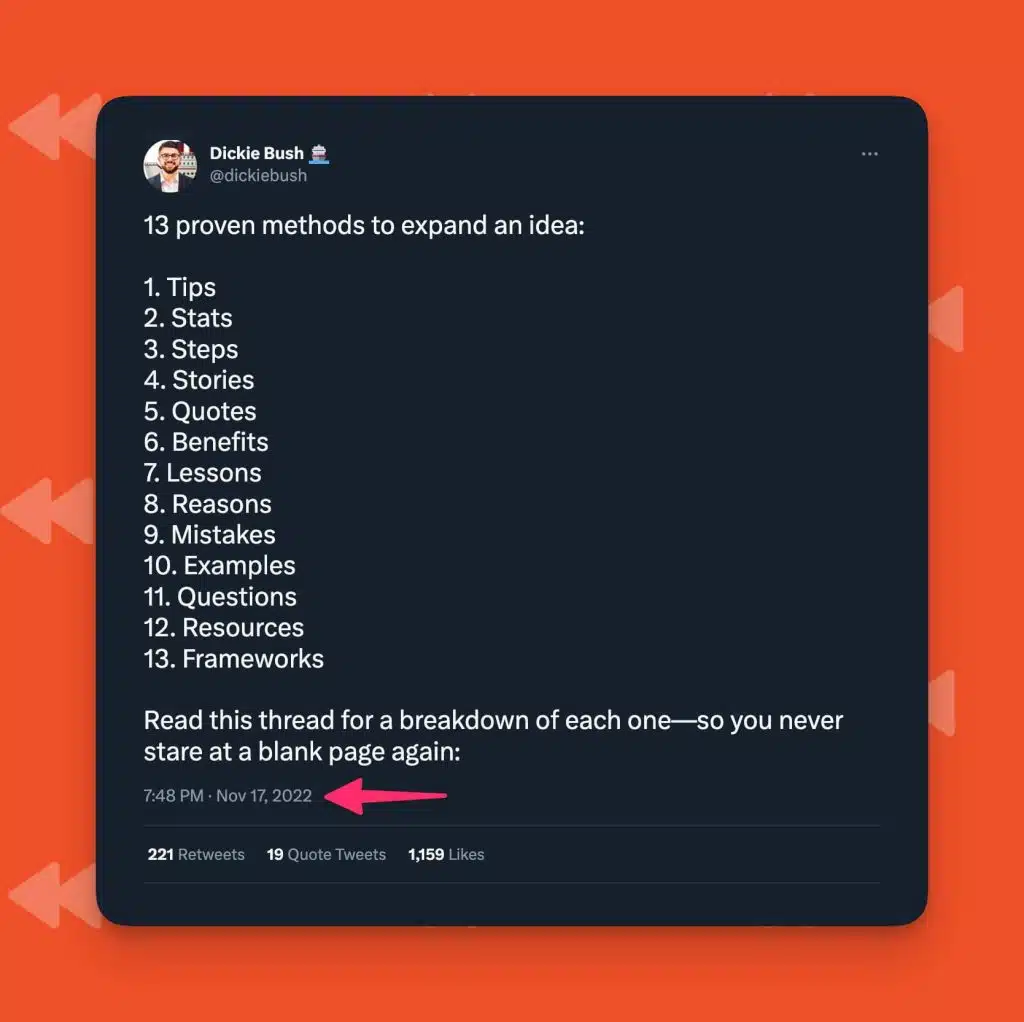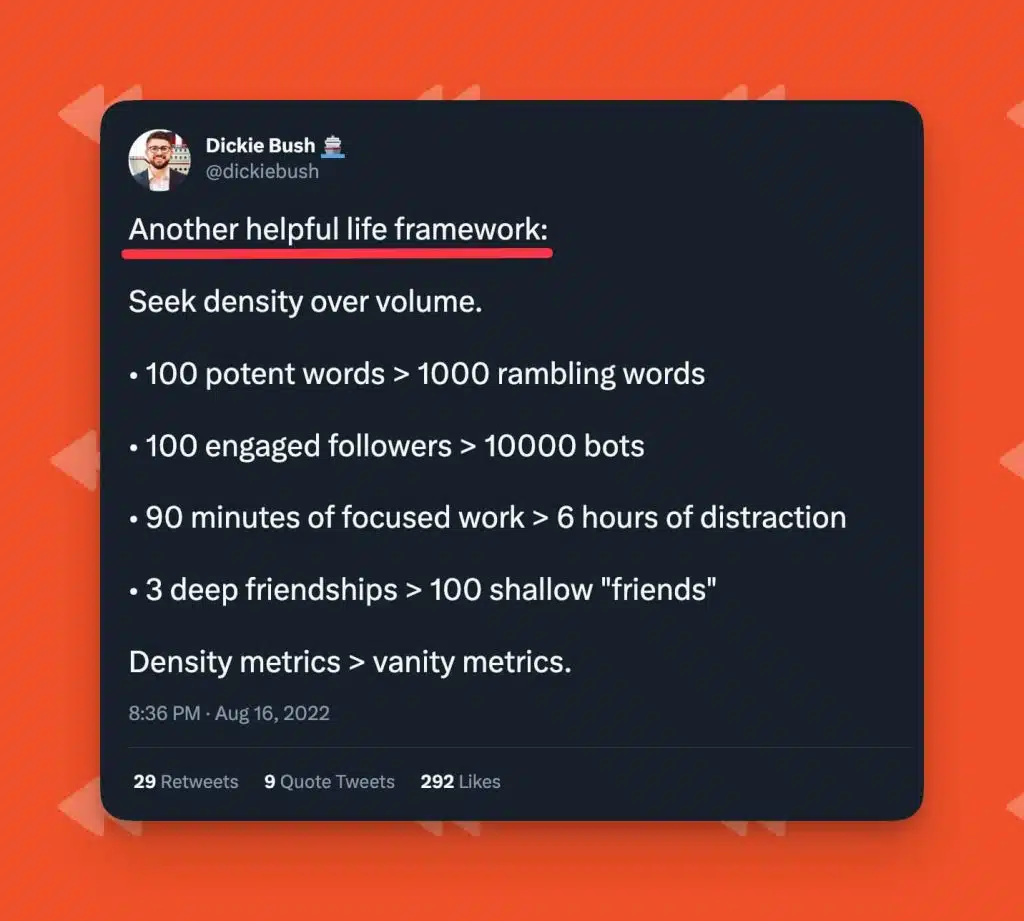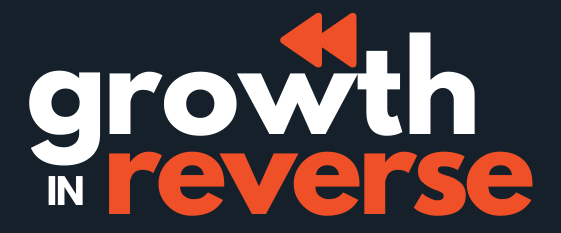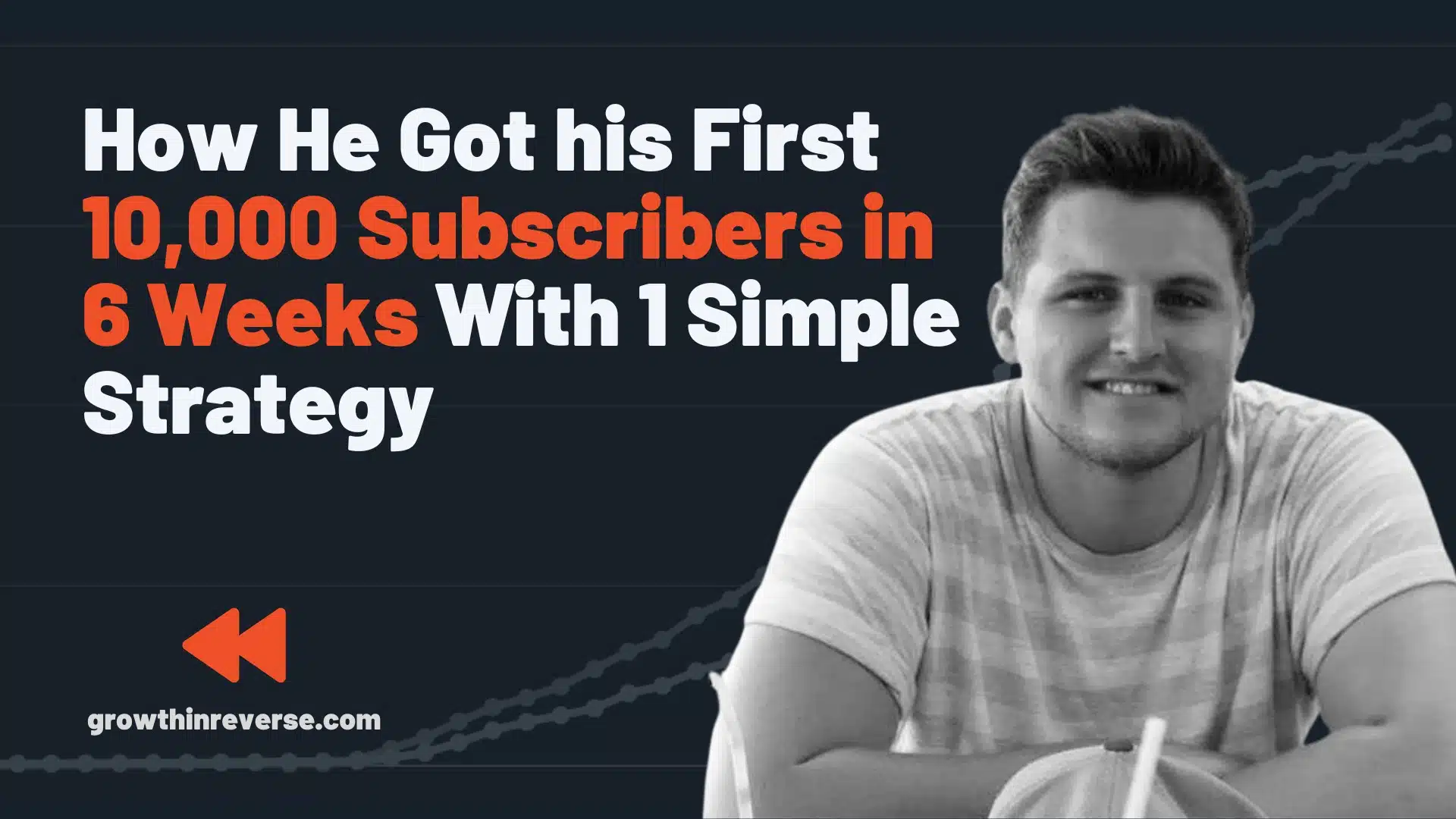Dickie Bush is one of the most prolific writers on the internet.
He went from having no following in January 2020, to over 326k followers today in March of 2023.
But he didn’t just hit the ground running. Quite the opposite.
For the first 9 months, he was seeing almost no traction and was writing his newsletter to crickets.
Fast forward to today, and he has over 326k followers on Twitter and has built a multi-million dollar business around teaching people how to write online.

How Dickie Bush Makes Money
Dickie has built a massive business and community about helping people learn to writing online. He has a business partner named Nicolas Cole, one of the most-read writers on the internet.
If you’re not familiar, they have a few different revenue streams at the moment.
Ship 30 For 30
Ship 30 For 30 is a cohort-based course designed to help you get started with digital writing. As the name suggests, you’re writing every day for 30 days with the other members of the cohort.
Along the way, Dickie and Cole teach you the fundamentals of writing online, as well as tips and strategies to be more prolific at creating.
The course started in 2021 at $50, and now runs $999.
First Mate
Once you sign up for Ship 30, you can upgrade to be a First Mate for $1,999.
This has personalized feedback from Cole and Dickie, along with a full behind-the-scenes walkthrough to how they run their course, and all the tools used.
If you’re trying to create a cohort-based course, it sounds like a no-brainer. I however am not doing that quite yet.
Captain’s Table
750 members in May 2022
All of these combined to over 7 figures in revenue
Unlike other writing courses where you learn passively – you'll create 30 pieces of published writing, build lifelong friendships, and leave with a new perspective for what is possible online.
Typeshare
Typeshare is a software product that Dickie and Cole co-founded with one of the Ship 30 original members.
It layers in perfectly with their course because the software enables you to write and publish on multiple platforms without having to leave Typeshare.
At the end of 2022, Typeshare was bringing in $29,000 MRR. Being super conservative and using those numbers, I’d say that Typeshare is a half a million dollar business on it’s own at this point.
The Growth Timeline
Dickie started writing online in January of 2020. He was writing a newsletter called “Dickie’s Digest” where he’d break down the ideas he was learning from reading and listening to podcasts.
Fast forward 9 months to September of 2020, and he only had around 300 subscribers.
He was getting frustrated and thought about giving up. But decided that if people weren’t going to find him, he needed to go to where the people were and double down on it.
The people were on Twitter. And so he committed to writing 30 threads in 30 days.
On day 28, just before he was ready to quit, Naval retweeted his thread and he doubled his small following overnight. From there, he was off to the races.

The Growth Levers of Dickie Bush
Twitter was one of the main ways Dickie has been able to build up a multi-million dollar business and following of around half a million people. So, this post is a little Twitter-heavy – but the principles apply elsewhere.
1. Micro-failures. The concept of micro-failures is brilliant and leads to Dickie knowing exactly what content is going to work before he spends the time creating it.
2. Mastering Twitter threads. On top of knowing what will work, Dickie combines that knowledge with some great best practices to make sure his Twitter threads do well..
3. The same content 1,000 ways. And no, this isn’t just a typical repurposing type of strategy. The beauty of this is that he’s able to create loads of content without having to spend a ton of time on it.
4. Being unreasonable. He might not be the best writer on the planet, but he knew if he could just put up unreasonable amounts of work, he would end up with an unreasonable result (i.e. 326k followers in 2.5 years).
1. Micro-Failures
While Dickie creates a lot of content, he’s not just blindly creating threads. He knows when something is going to work before he even writes it.
This concept kind of blew my mind when I realized what was happening.
How does he know it will work? He simply validates the idea first.
Instead of just coming up with an idea and writing a full thread about it first, he puts the idea out as a single tweet.
He puts out around 8-10 single tweets each week. And then takes the top 2 based on engagement, and writes full threads about them.
Here are a few examples for you.
Example 1: Actionable Tips to 10x Your Writing
The first tweet he posted July 8, 2022. A simple listicle tweet with 6 ideas, a hook, and an ending.


That tweet got over 1,600 likes, so he saw that as a sign it was resonating with people.
On August 3rd, he posted a full thread where he expanded upon each tip.
That thread also got over 1,000 likes.
Some of his tweets get around 300 likes, so that’s a big jump and something I’d want to capitalize on as well.
Example 2: Ways to Expand Ideas
Here’s a more recent one in action:


While these look like the exact same tweet, the second one he posted on November 17 is actually a thread.
So below this main tweet, he goes into each way to expand an idea.
At the end, he pitches the newsletter of course 🙂
The cool part about this strategy is that the thread got even more likes than the original tweet did.
Why This Works
Well, this works for a few reasons. He’s only creating threads around the content his audience is resonating with at that time.
He’s listening to the data.
One of the other tweets he wrote that week got less than half of the engagement:

Of course, I would be THRILLED with 381 likes on a tweet. But if you look back to the previous one, it had 863 likes.
You have to take these signs as messages from your audience that they weren’t as interested in that other thing.
It’s just a smart way to play the game.
So, let’s talk more about Dickie’s threads and how he makes sure the topic and format work well together.
2. Mastering Twitter Threads
Dickie has gone from not understanding Twitter at all to being masterful at threads in such a short amount of time.
He even writes threads about threads that get amazing engagement.
So, let’s dive into some of the tips he’s using to write better threads.
First Off, Why Threads?
Aside from referrals, Twitter threads are the main driver of growth for both the newsletter and Ship 30 For 30.
Threads are also touted as one of the best ways to get followers on Twitter. While single tweets are great, they don’t often result in a lot of followers.
On top of that, threads give you a better chance to resonate with your audience. You have more room to show your personality and provide more value for your followers.
Prepping the Page
Before he even starts writing, Dickie does what he calls “prepping the page” so he’s not starting from a completely blank page.
Here are 6 questions he adds to the page before he starts writing:
- What problem am I solving?
- Whose problem am I solving?
- What are the benefits of solving the problem?
- What promise am I making to the reader?
- What emotion am I trying to generate?
- What’s the next action I want my reader to take?
These questions help him drill down to better understand the outcome and audience he’s trying to help.
Having this specificity makes the writing process easier because you’re more fully thinking through the topic and the reason behind the post you’re creating.
All the tactics in the world don’t matter if the content isn’t helping someone or providing value in some way.
Writing Great Hooks
The hook of the tweet is the most important part. It’s kind of like a YouTube video thumbnail – if it sucks, no one is going to keep reading.
You want to get people to stop scrolling and start reading.
Here are some of the tactics Dickie uses that you can use to create a really powerful hook.
Using Big Numbers
People love seeing big numbers. It almost adds to the intrigue of everything.
Here’s an example of Dickie using big numbers to catch people’s attention.
This is one of the most viral threads Dickie has created. He actually recorded himself writing it if you’re interested in seeing the full process.
Proper Formatting
Make sure you’re not putting out a huge block of text in your tweets.
- Use bullet points
- Bold important words and phrases
- Only use 1-2 sentences per paragraph
Be Clear NOT Clever
You can skip the fancy titles or attempts at being clever when you’re writing online.
Write to a 5th Grader
Get rid of the big words, unless you’re writing to professors on LinkedIn.
In any other instance, you can probably scrap them.
- Instead of “assistance” say “help”
- Instead of “compose” say “create”
You get the idea. The goal is to help people read your writing, what you don’t want to do is slow them down when they’re reading.
When In Doubt, Get More Specific
Specificity is a great way to keep people reading.
- Add more details to the story
- Include more numbers
- Narrow down who you’re talking to
If you’re having trouble writing, it’s probably because you need to be more specific.
Using Thread Templates
If you’ve studied any of the top creators on Twitter, you’ll know that many of them use templates to help generate ideas and content quickly.
Here are some of the templates I’ve found that Dickie uses.
Lessons as a 101
This is a common template you’ll see floating around Twitter. Everyone from Sahil Bloom to Justin Welsh has used it – and that’s because it works.
Or at least it did. It seems like people are getting really tired of some of these.
But, you can do it in a different way and stand out.
Thread of Threads
Threads of threads are just what they sound like – a long thread of your best threads.
Dickie uses these in a variety of ways:
- At the end of the year (I grew by X followers, here are the 10 threads that led to this growth)
- When you’ve written about a specific topic comprehensively.
- Compiling other people’s content
These seem to work really well when done correctly.
“Another”
This is more of a prompt than a template, but it still applies.
I love this one because it kind of breaks that barrier of you feeling like you have to come up with gold every single time.
Yes, you want your content to be valuable. But this “another” framework allows you to just add on to something you’ve done in the past.


Those 2 are good examples on their own, but you can also use this to add “another” tip to a previous tweet you’ve written.

With this one, Dickie wrote a tweet about the 3 traits of high performers.
The next day, he added a fourth to it and got almost the same amount of engagement that as that first tweet.
Reach Content vs Resonance Content
I’ve been struggling with the concept of writing about super broad topics because they don’t seem to resonate as well as the really specific stuff does.
Dickie breaks this down in a great way when he talks about reach content vs resonance content.
Reach Content
Reach content is the stuff that has a massive potential audience. These pieces of content have the chance to go viral.
Let’s say you help people course creators sell more courses with emails. Your profile should talk about how you do that for course creators. But your reach tweets might look like this.
Example of reach content:
- Copywriting tips you can use when writing emails
Reach content should be used around 75% of the time to build up a larger audience.
Resonance Content
Resonance content is where you’re speaking to a specific type of person.
Example of resonance content:
- Copywriting tips to use to help you sell more courses
Resonance content should be used around 25% of the time to strengthen that relationship with your core audience.
Your content is still valuable to those more broad audiences, and by having content that sometimes goes “viral” will help you find more of those “niche” people who resonate even more with your content.
You want a broad audience and a niche audience.
3. Finding 1,000 Ways to Convey the Same Message
The most prolific creators aren’t just creating new stuff all the time.
They find the main topics they want to write about that also resonate with their audience, and then they dive deep into those.
In Dickie’s words:
I went down the rabbit hole and learned how to use Figma (be nice!) so I can more easily show you some examples.
Here is the creation embedded, but you can also use this link to view it as well.
You can scroll around and zoom in to see each tweet.
Essentially, Dickie created a thread about how you can learn more quickly. It’s a 3-part framework that he dives into within that thread.
But after that, I found 10 more tweets that he posted after this thread that all related to the main topic. He broke out 1 of the 3 parts of the framework and dug deeper into it. Or he repurposed the main ideas from the thread.
And then tweets and threads link back to that original thread. Which just compounds on itself and leads to the thread getting even more reach.
Mind-blown.
It’s no wonder it was one of his top 10 threads in all of 2022. He kept driving people back to this content.
GENIUS.
4. Being Unreasonable
It might be Dickie’s background as a football player, but he is puts together a solid plan he knows will drive results…
And then he just relentlessly follows the plan.
But not just that, he knows that if he just puts out an obscene amount of volume, consistently, he’s going to rise above a lot of people who are doing just the bare minimum.
- He puts out an unreasonable amount of content. In the beginning, he was putting out 5 tweets per day. Again, these were all data points that helped him see what resonated.
- He does this at an unreasonable clip. Dickie is never spending more than an hour on a piece of content unless he knows it will work.
Dickie says that every time he puts out a piece of content, or does a monotonous, but important, task, he pictures himself leapfrogging someone who quit at that exact moment.
I love this because he’s turning this business into a game.
Justin Welsh thinks of business as a game as well, and it’s helped him grow a multimillion-dollar business as well.
Dickie knows he’s not the best writer on the planet, but he combines volume, speed, and data points to grow faster than those who might be better.
Join Me in Ship 30?
Last week, I signed up for Ship 30 For 30 because I need to build a better habit of writing on Twitter/LinkedIn.
I’d love to have some Growth in Reverse community members join me if you’re up for it.
It’s not cheap, but I see the cost as an investment in helping me grow and become a better writer.
If you sign up, please use this link, and DM me on Twitter/LinkedIn if you join.
As a bonus, I’ll put together some sort of accountability group and/or share the lessons I’ve learned with you along the way. Looking forward to seeing you there!
Unlike other writing courses where you learn passively – you'll create 30 pieces of published writing, build lifelong friendships, and leave with a new perspective for what is possible online.





